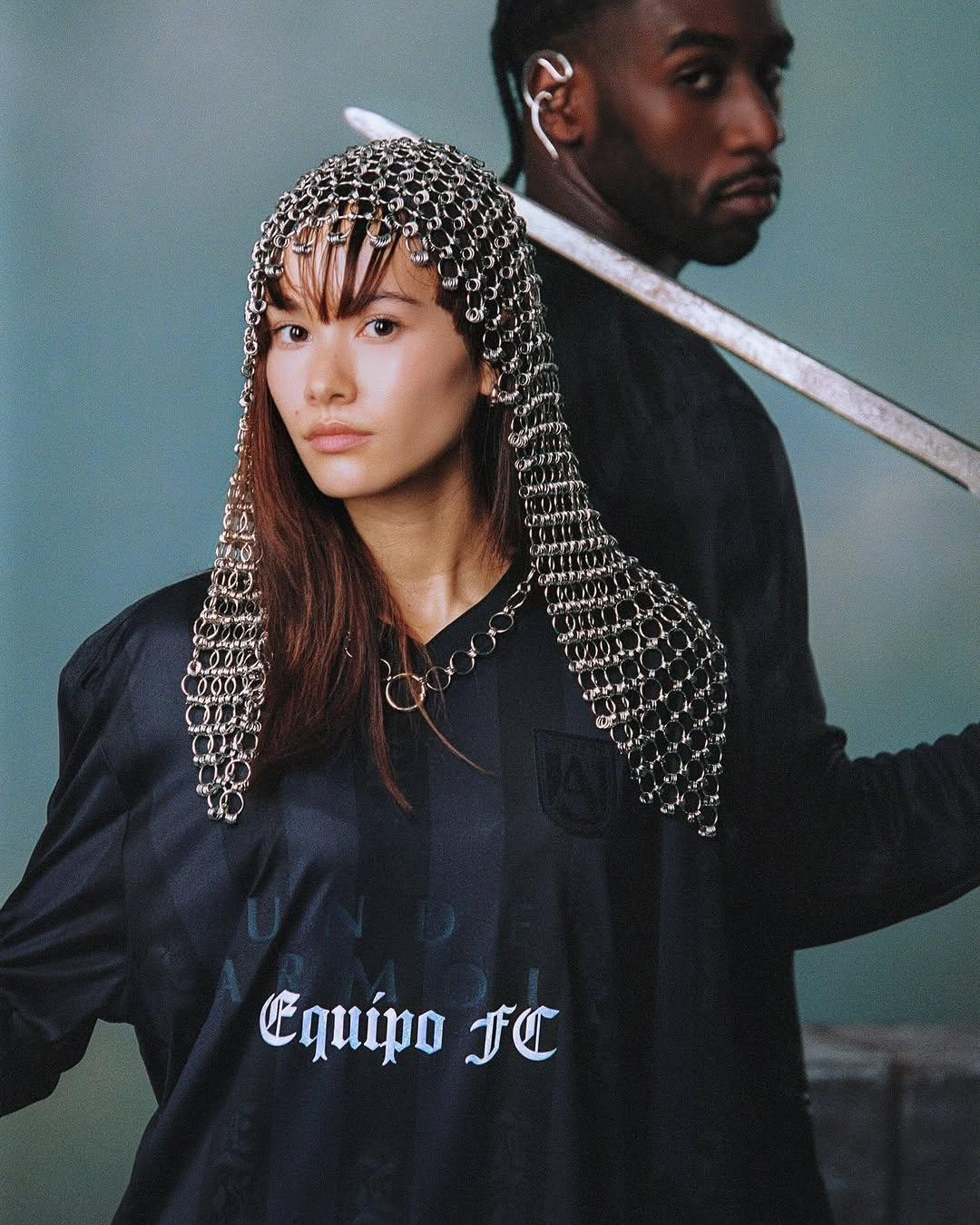

For years, Under Armour has occupied a reliable, if uninspired, corner of the sportswear industry–a brand synonymous with performance gear, locker room grit, and compression technology. It was built for athletes, not aesthetics. But in 2025, a quiet storm is brewing beneath the surface, and it looks like Under Armour is preparing for one of the most unexpected pivots in contemporary fashion. The brand is slowly but deliberately embedding itself within underground culture, niche football collectives, and high-fashion circles. From its recent sightings on Playboi Carti to its gritty collaboration with Equipo FC and past alignment with Balenciaga’s dystopian runway, Under Armour is no longer just a brand for the gym. It’s becoming a player in fashion’s future.
The internet buzzed recently when a photo emerged of Playboi Carti wearing what appeared to be a co-branded Opium x Under Armour headpiece. For most brands, this would be just another celebrity sighting. But Carti–enigmatic, selective, and worshipped by style-forward Gen Z audiences–doesn’t wear things by accident. His aesthetic universe, built around the cult-like energy of his Opium collective, is dark, futuristic, and intentionally obscure. For Under Armour to enter that space, even subtly, is a radical shift. It wasn’t flashy, but it was surgical. The headwear symbolized a cultural alignment, not just a branding opportunity. It said, “We see where fashion is headed–and we’re not just catching up. We’re already there.”
Earlier this year, Under Armour raised more eyebrows when it partnered with Equipo FC, a Madrid-based football collective known for its raw aesthetic and ability to merge community sports with contemporary fashion. The collaboration was not a mainstream rollout but rather a focused, street-savvy drop that looked like it belonged on the sideline of a rave as much as a football pitch. It didn’t scream for attention–it whispered credibility. The project was widely praised for its balance of performance and underground appeal, showing that Under Armour could speak the language of modern style without losing its technical backbone.
This isn’t a one-off experiment. Under Armour’s subtle infiltration of fashion circles started taking shape as early as last year, when their gear made quiet appearances in Balenciaga’s increasingly dystopian universe. While never officially named as a collaborator, UA’s distinct performance wear was layered into outfits in runway shows and stylized campaigns, co-signing the brand’s aesthetic for fashion’s most avant-garde crowd. Whether intentional or incidental, it offered a clear message: Under Armour’s utilitarian, hyper-functional identity was being embraced by designers who prize post-apocalyptic silhouettes and brutalist simplicity. In an age where utility is becoming high fashion, Under Armour’s DNA is more valuable than ever.
What makes this moment especially ripe is the broader fashion shift toward “techno-sport” and utilitarian design. Labels like A-COLD-WALL, Salomon, and Arc’teryx have successfully blurred the line between functionality and cultural cool, creating a new visual language rooted in survivalism and athletic edge. Under Armour, whose foundations are built on compression gear, heat regulation, and performance-first thinking, fits naturally into this trend without needing to reinvent itself. All it has to do is adjust its context–reframe its products not just as gear for athletes, but as uniforms for the next wave of youth culture. And it seems that’s exactly what it’s doing.
Behind the curtain, Under Armour has been recruiting new creative forces–young designers and art directors fluent in the visual codes of both sport and subculture. While not as publicized as Nike’s or Adidas’ design coups, these hires hint at a shift in UA’s visual storytelling. Their future campaigns are expected to lean more editorial, more moody, more fashion-forward. This rebranding isn’t being shouted from billboards; it’s being whispered through curated shoots, cryptic product placements, and cultural osmosis. There are even murmurs of involvement from A$AP Rocky’s AWGE circle–a collective known for forecasting fashion’s next frontier. While no formal partnership has been announced, the proximity of Rocky’s world to Carti’s suggests something larger may be brewing within that creative sphere.
Perhaps the most exciting part of this evolution is that Under Armour doesn’t need to scale up–it’s already there. Unlike emerging fashion brands that struggle with manufacturing and distribution, UA has the infrastructure, retail presence, and global clout to dominate once its repositioning locks in. If it chooses to, it can deliver edgy, culturally relevant products on a mass scale without compromising authenticity–a rare position in the world of fashion-sport hybrids. And with key cultural moments on the horizon–Paris Fashion Week, the 2025 Olympics, and the NBA’s growing intersection with style–Under Armour has the perfect runway to make a statement.
What we’re witnessing is a brand that’s no longer content with being on the sidelines of style. Under Armour is playing a long game: strategically aligning with subcultures, dipping into fashion’s darker, more esoteric aesthetics, and letting the right people wear the right pieces at the right time. It’s not chasing virality. It’s courting legacy. In a few years, we may look back at the Carti photo or the Equipo FC collab as the moment it all clicked. But make no mistake–whatever Under Armour is cooking, it’s already simmering. And the fashion world is starting to take notice.



